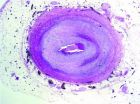It takes a village: Mechanism alerts neighbors to amplify immune response
2010-11-19
(Press-News.org) The pathogen Shigella flexneri invades the cells that line the gut and causes Shigellosis, a disorder characterized by diarrhea and sometimes even death in humans. S. flexneri subverts the normal immune response of the host by interfering with the ability of the infected cell to secrete chemicals called chemokines that stimulate inflammation. Inflammation is a complex response to pathogens that attracts white blood cells to destroy the bacteria. Despite the documented ability of S. flexneri to suppress inflammation in infected cells, intestinal cells do secrete large amounts of chemokines and exhibit substantial inflammation during Shigellosis.
Professor Cécile Arrieumerlou from the University of Basel in Switzerland led a study designed to investigate the molecular mechanisms that control inflammation during bacterial infection. Using a sophisticated microscopic technique that allowed analysis of S. flexneri infection at the single cell level, the researchers discovered that activation of proinflammatory signaling pathways is propagated from infected cells to adjacent uninfected cells, leading to chemokine secretion from the bystander cells. "We found that this mechanism was mediated by specialized intercellular connections called gap junctions that allowed the infected cells to communicate with neighboring uninfected cells," explains Prof. Arrieumerlou.
Taken together, the results show that even when the immune response is suppressed in the infected cell, alerted bystanders can amplify the inflammatory response. "We have identified a novel mechanism of cell to cell communication that amplifies the immune response against bacterial infection by rapidly spreading signals via gap junctions to yet uninfected cells," concludes Prof. Arrieumerlou. "This mechanism enables the host to circumvent the immunosuppressive activity of bacteria and to massively amplify inflammation during bacterial infection."
INFORMATION: END
ELSE PRESS RELEASES FROM THIS DATE:
2010-11-19
Researchers have uncovered a fundamental link between the two defining properties of quantum physics. Stephanie Wehner of Singapore's Centre for Quantum Technologies and the National University of Singapore and Jonathan Oppenheim of the United Kingdom's University of Cambridge published their work today in the latest edition of the journal Science.
The result is being heralded as a dramatic breakthrough in our basic understanding of quantum mechanics and provides new clues to researchers seeking to understand the foundations of quantum theory. The result addresses the ...
2010-11-19
Panama Canal, PanNew data suggest that the Limon and Pedro Miguel faults in Central Panama have ruptured both independently and in unison over the past 1400 years, indicating a significant seismic risk for Panama City and the Panama Canal, according to research published today by the Bulletin of the Seismological Society of America (BSSA).
The Panama Canal is undergoing expansion to allow for greater traffic of larger ships, scheduled for completion by 2014. As part of a seismic hazard characterization for the Panama Canal Authority (ACP) expansion project, Rockwell, ...
2010-11-19
Over the last 15 years, astronomers have detected nearly 500 planets orbiting stars in our cosmic neighbourhood, but none outside our Milky Way has been confirmed [1]. Now, however, a planet with a minimum mass 1.25 times that of Jupiter [2] has been discovered orbiting a star of extragalactic origin, even though the star now finds itself within our own galaxy. It is part of the so-called Helmi stream — a group of stars that originally belonged to a dwarf galaxy that was devoured by our galaxy, the Milky Way, in an act of galactic cannibalism about six to nine billion years ...
2010-11-19
Understanding the evolution of life-threatening viruses like influenza, Ebola and dengue fever, could help us to minimize their impact. New research points the way to a fossil record of viruses that have insinuated themselves into the genomes of insects and other animals, providing clues about their evolutionary history. The findings, published online on November 18 in the open-access journal PLoS Genetics, could enable scientists to elucidate general principles in virus evolution from their genetic "fossils", which in turn could inform approaches for controlling disease.
Robert ...
2010-11-19
LA JOLLA, CA – November 16, 2010 – A team led by scientists at The Scripps Research Institute has solved the structure of one of the receptors that responds to the neurotransmitter dopamine. Although dopamine transmission is essential to normal brain functioning, the biological assembly of the molecules involved in this crucial neuronal interplay had not been known—until now.
The work was reported in the November 19, 2010, issue of the journal Science.
In the new study, whose authors included collaborators from Weill Cornell Medical College, Receptos, the National Institute ...
2010-11-19
As experts gather in St Petersburg, Russia for next week's Tiger Summit, fewer than 3,200 tigers survive in the wild worldwide. More than half live in India, where they are spread over a vast area (100,000 sq km) of forest.
According to Dr Yadvendradev Jhala of the Wildlife Institute of India, lead author of the new study: "Tigers are cryptic, nocturnal and occur at low densities so they are extremely difficult to monitor. Unless we know how many tigers are left in the wild, and whether their numbers are increasing or decreasing, we will not be able to conserve them."
Until ...
2010-11-19
Cough medicine could be used as way of predicting how well individual patients metabolise tamoxifen used in the treatment of their breast cancer, according to new research presented at the 22nd EORTC-NCI-AACR [1] Symposium on Molecular Targets and Cancer Therapeutics in Berlin today (Friday).
The findings suggest that it could be possible to use cough suppressant syrup as a probe, which would enable doctors to identify patients with altered metabolism and use this information to improve individual treatment, making it more effective and reducing the chances of side-effects. ...
2010-11-19
Researchers have found that a newly developed drug, which is aimed at a particular receptor involved in the development of blood vessels that sustain tumour growth, is active in patients with advanced cancers and, in some cases, has halted the progress of the disease. The drug, ACE-041, targets a different molecular pathway to other anti-angiogenesis drugs and may provide a new option to treat cancer.
Results from a phase I clinical study of ACE-041 were presented at the 22nd EORTC-NCI-AACR [1] Symposium on Molecular Targets and Cancer Therapeutics in Berlin today (Friday). ...
2010-11-19
UCLA researchers have pinpointed the culprit behind chronic rejection of heart, lung and kidney transplants. Published in the Nov. 23 edition of Science Signaling, their findings suggest new therapeutic approaches for preventing transplant rejection and sabotaging cancer growth.
The team focused on the mechanism behind narrowing of the donor's grafted blood vessels, which blocks blood from reaching the transplanted organ. Starved of oxygen and other nutrients, the organ eventually fails, forcing the patient back on the transplant waiting list.
"Chronic rejection ...
2010-11-19
It may have been 1 billion years since plants and animals branched apart on the evolutionary tree but down through the ages they have developed strikingly similar mechanisms for detecting microbial invasions and resisting diseases.
This revelation was arrived at over a period of 15 years by teams of researchers from seemingly disparate fields who have used classical genetic studies to unravel the mysteries of disease resistance in plants and animals, according to a historical overview that will appear in the Nov. 19 issue of the journal Science.
The report, written ...
LAST 30 PRESS RELEASES:
[Press-News.org] It takes a village: Mechanism alerts neighbors to amplify immune response



